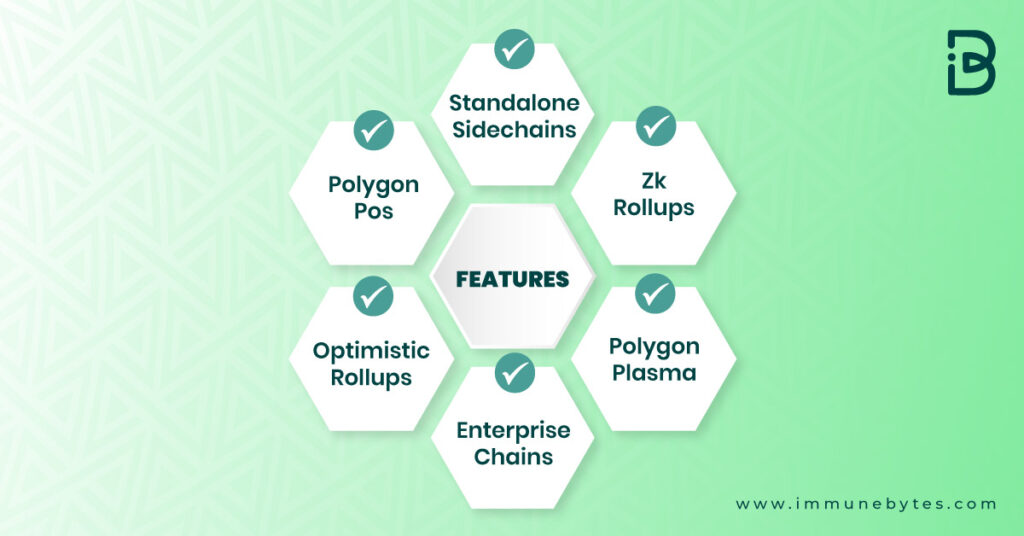In February 2021, Matic Network rebranded as Polygon, which has been on the radar of crypto frenzies.?
Polygon is an Indian blockchain scalability platform called ‘Ethereum’s Internet of Blockchains.’ It aims to bring the adaptability and scalability of alt chains along with Ethereum’s security, liquidity, and interoperability.?
This article will give you an insight into the technical infrastructure of Polygon- its unique features and how it works. Let’s dive in!
Additional Resource: INTRODUCTION TO POLYGON
How Does Polygon (Matic) Network Work?
Table of Contents
While Matic was designed as a simple layer-2 scaling solution for Ethereum, Polygon is the infrastructure for a network of massively scaling, collaborative blockchains that retain their self-sovereignty.?
Polygon’s architecture can best be defined as a four-layer system composed of the following:?
- Ethereum layer
- Security layer
- Polygon networks layer?
- Execution layer
Polygon has fostered a layer-2 network for building interoperable, Ethereum-viable blockchains.?
The MATIC Sidechain operates like every other Proof-of-stake-based blockchain. Its structure, token, client nodes, local DApps, validator nodes, etc., are similar to other networks except for the factor that exchanges are clustered and settled over the Ethereum mainchain.
Diving Deeper in Polygon
- The Ethereum Layer: This layer is essentially a set of smart contracts which are implemented on Ethereum. These smart contracts maneuver things like transaction finality, staking, and communication between Ethereum and the various Polygon chains.?
- The Security Layer: The layer runs alongside Ethereum, offering a “validators as a service” role. This allows chains to benefit from an additional layer of security.?
The best part, both the Ethereum and Security layers are optional! The other two, however, are Polygon’s mandatory layers.
- The Polygon Networks Layer: This ecosystem of blockchain networks is built on Polygon. Each has its community and is responsible for handling local consensus and producing blocks.
- The Execution Layer: This last layer is responsible for executing smart contracts?and implementing Polygon’s Ethereum Virtual Machine (EVM).
The modularity of Polygon for assembling custom networks allows developers to send preset blockchain networks with just one snap. Besides this, Polygon makes it simpler for any blockchain to cooperate with another blockchain.
The Polygon platform is designed to support a wide range of blockchain scaling mechanisms, including Matic Plasma, zk Rollups, Optimistic Rollups, and Validum Chains ? all of which multiply the transaction throughput of associated blockchains without compromising on security or user experience.
Technologies Polygon Uses?

Polygon employs a wide variety of technologies and solutions to achieve its expanded vision. These features include:?
- Zk Rollups: An alternative scaling solution used to bundle a large number of transfers off-chain into a single transaction, using zero-knowledge proofs for the final public record on the Ethereum main chain.
- Polygon POS: Polygon’s main chain is an Ethereum sidechain known as the Matic POS Chain, which adds a proof-of-stake (POS) security layer to blockchains launched on Polygon.
- Polygon Plasma: A Plasma Chain is simply a set of contracts that help move assets from the root chain to the child chain.
- Optimistic Rollup: An Ethereum Layer 2 solution to facilitate near-instant transactions through the use of “fraud proofs?.
- Standalone Sidechains: Sovereign Ethereum sidechains that are secured by their own set of validators and optionally connected to Ethereum via bridges.
Polygon combines the best of Ethereum and sovereign blockchains into a full-fledged multi-chain system.?
Polygon envisions a network in which various blockchains are able to freely and easily exchange value and information ? doing away with the technological and ideological divides that separate most blockchains of today.
Recommended: Polygon Matic Security Audit?
Some Insights on the MATIC token
Despite rebranding itself as Polygon and dramatically expanding the vision laid out by Matic Network, it still uses the native utility token MATIC.
The MATIC token is currently sailing at $1.03 with a market capitalization of $6B+.

Source: https://coinmarketcap.com/currencies/polygon/
The MATIC token is used for a number of purposes in the Polygon ecosystem, including:
- Participating in network governance by voting on Polygon Improvement Proposals (PIPs),?
- Contributing to security through staking
- Paying gas fees
The token is currently one of the top 100 largest cryptocurrencies by market capitalization and benefits from excellent liquidity. MATIC is accessible on most well-known decentralized as well as centralized-based tradings, including some of the famous names like Binance, 1inch Exchange, and Coinbase Pro in the list.
Final Thoughts
The Polygon Network has the potential to become one of the leading blockchain platforms in the coming future. By looking at the platform’s workings and popularity, it has already shown considerable success in solving blockchain challenges, most importantly the scalability issues.
It hasn’t been long since Polygon was announced and seeing its growth, it would be exciting to anticipate what’s in store for the future! The team is making strides in forging partnerships with large tech companies to launch its first speculation markers on Polygon!
About Us
ImmuneBytes is facilitating blockchain security by using cutting-edge techniques on smart contracts Audit?and decentralized?applications security. We have a team of experienced security professionals who are adept at their niches and provide you with innovative solutions and consultation. So far we have worked on 175+ blockchain start-ups on different blockchain frameworks, with clients spread across the globe, and are continually unfolding ourselves to make this decentralized movement thrive.

